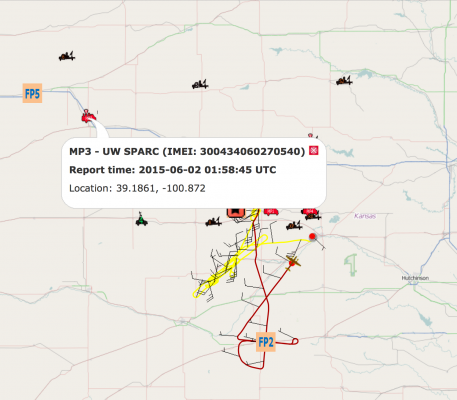PECAN 2015: Field campaign pursues mysteries of nighttime storms

A map showing the SPARC’s deployment on June 2, 2015, the second day of PECAN operations. Each of the red vehicle icons represents the four mobile units. Credit: Wayne Feltz, SSEC.
When the Sun heats the Earth’s surface, warm air rises, causing convection and sometimes storms. Yet, what happens at night – when the Sun is not out? Scientists know far less about nocturnal storms.
For this reason hundreds of scientists, equipped with more than 100 highly specialized scientific instruments, are traveling to a remote region of the Great Plains – near Hays, Kansas – to study this specific type of convection. The campaign, called Plains Elevated Convection At Night (PECAN), is the first major coordinated effort to attempt to answer this science question.
Funded by the NSF, NASA, NOAA, and the U.S. Department of Energy, the campaign will last from June 1-July 15, 2015. Experimenters hail from a variety of institutions and universities across the U.S.
SSEC’s field team for PECAN comprises Wayne Feltz, Chris Rozoff, Tim Wagner, Erik Olson, Lee Cronce, Nadia Smith, John Lalande, Andrew Wagner, David Loveless, Michelle Feltz, and Sarah Witman, as well as off-site support. The SSEC team conducted a dry run in Madison in mid-May, and several members are already stationed at the field site.
The SSEC Portable Atmospheric Research Center (SPARC), a specially modified vehicle carrying instruments to study the atmosphere and make surface emissivity measurements, will be one of four mobile units deployed at PECAN. Each mobile unit, as well as six fixed units across Kansas and Nebraska, is equipped with various radars, lidars, radiosondes, and other sensors. Three aircraft will also be deployed to collect mesoscale data before convection begins.
The SPARC is equipped with an Atmospheric Emitted Radiance Interferometer (AERI) to measure radiant energy from the Earth’s atmosphere, and a High Spectral Resolution Lidar (HSRL) for detecting aerosols. SSEC will launch up to 200 radiosondes from the ground, using weather balloons, which transmit data back to an onboard receiving station.
Wayne, Chris, and Tim will be stationed at the campaign’s Operations Center in Hays to help with forecasting. When a nighttime storm is predicted, as is common for the region this time of year, the mobile crews will prepare the instrumentation and head out, in fleet formation, in the late afternoon – hopefully reaching their destinations before nightfall, to avoid working in the dark. Once everything is set up, the crews will collect as much environmental data as possible before the storm hits.
An inherent challenge of studying nighttime storm formation is the potential for strong wind gusts and other pre-storm activity, during which the researchers will need to pack up their gear safely and quickly. For those brief periods, the stars, moon, and flashes of lightning will be their only natural light sources.
Then, it’s back home (a dormitory-style housing complex in Hays) to squeeze in some sleep before the next day – there are also pre-planned rest days for safety. The data the crews are able to collect (along with those from the aircraft and fixed units, which operate continuously) will be analyzed to provide clues about nighttime convection, as well as for short-term forecasting applications.
Please watch the SSEC News page as well as our social media accounts for more updates – we will be using the #PECAN15 hashtag. More general information on the campaign may be found at PECAN15.org.
by Sarah Witman
